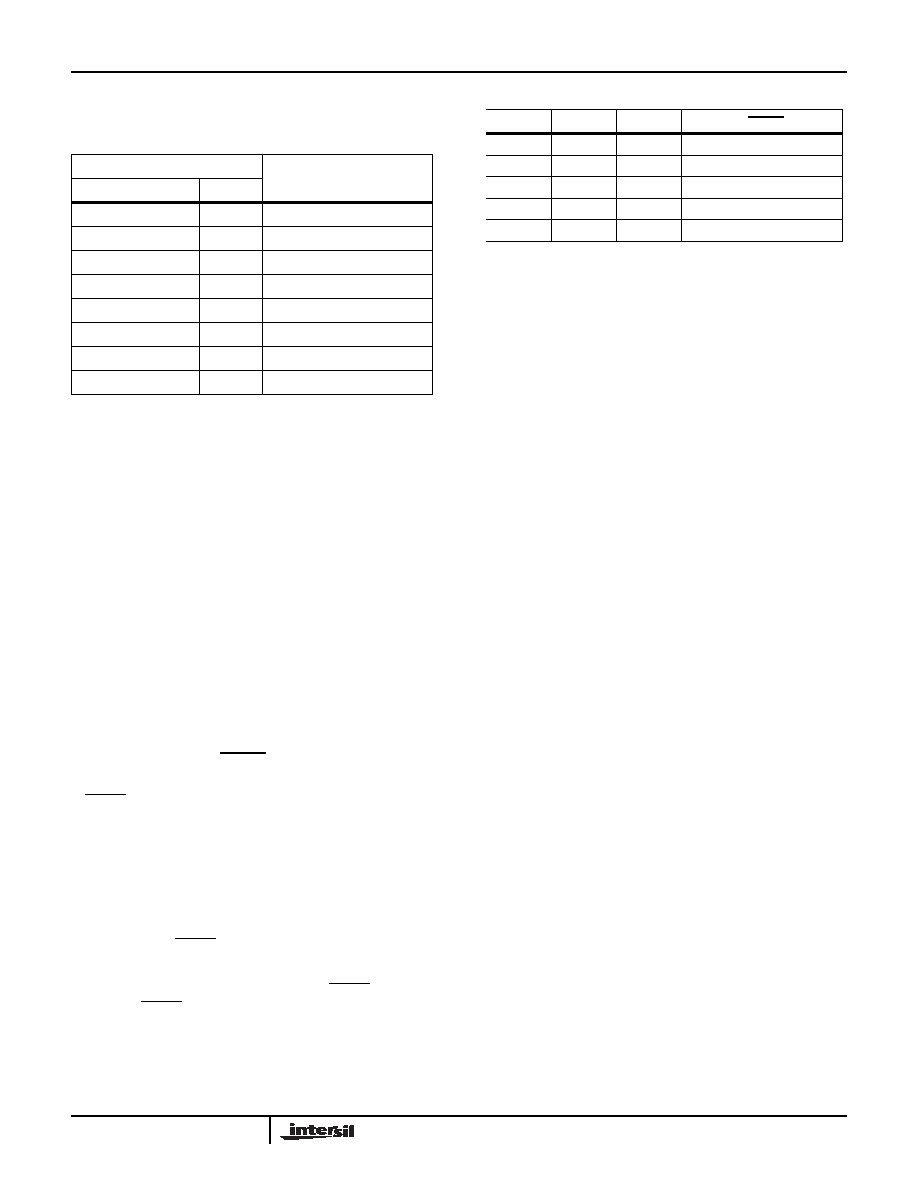参数资料
| 型号: | ISL12025IVZ |
| 厂商: | Intersil |
| 文件页数: | 5/27页 |
| 文件大小: | 0K |
| 描述: | IC RTC/CALENDAR EEPROM 8-TSSOP |
| 标准包装: | 960 |
| 类型: | 时钟/日历 |
| 特点: | 警报器,闰年,监控器,唯一 ID,监视计时器 |
| 时间格式: | HH:MM:SS(12/24 小时) |
| 数据格式: | YY-MM-DD-dd |
| 接口: | I²C,2 线串口 |
| 电源电压: | 2.7 V ~ 5.5 V |
| 电压 - 电源,电池: | 1.8 V ~ 5.5 V |
| 工作温度: | -40°C ~ 85°C |
| 安装类型: | 表面贴装 |
| 封装/外壳: | 8-TSSOP(0.173",4.40mm 宽) |
| 供应商设备封装: | 8-TSSOP |
| 包装: | 管件 |
第1页第2页第3页第4页当前第5页第6页第7页第8页第9页第10页第11页第12页第13页第14页第15页第16页第17页第18页第19页第20页第21页第22页第23页第24页第25页第26页第27页

13
FN6371.3
August 13, 2008
A range from -30ppm to +30ppm can be represented by
using the three ETR bits previously explained.
PWR Register: SBIB, BSW, VTS2, VTS1, VTS0
SBIB: Serial Bus Interface (Enable)
The serial bus can be disabled in Battery Backup Mode by
setting this bit to “1”. This will minimize power drain on the
battery. The Serial Interface can be enabled in Battery
Backup Mode by setting this bit to “0” (default is “0”). See
BSW: Power Control Bit
The Power Control bit, BSW, determines the conditions for
switching between VDD and Back Up Battery. There are two
options:
Option 1. Standard: Set “BSW = 0”
Option 2. Legacy /Default Mode: Set “BSW = 1”
See “Power Control Operation” on page 14 for more details.
LVR Operation” on page 23 for important details.
VTS2, VTS1, VTS0: VRESET Select Bits
The ISL12025 is shipped with a default VDD threshold
This register is a non-volatile with no protection, therefore
any writes to this location can change the default value from
that marked on the package. If not changed with a
non-volatile write, this value will not change over normal
operating and storage conditions. However, ISL12025 has
four (4) additional selectable levels to fit the customers
application. Levels are: 4.64V (default), 4.38V, 3.09V, 2.92V
and 2.63V. The VRESET selection is via 3 bits (VTS2, VTS1
and VTS0). See Table 5.
Care should be taken when changing the VRESET select
bits. If the VRESET voltage selected is higher than VDD, then
the device will go into RESET and unless VDD is increased,
the device will no longer be able to communicate using the
I2C bus.
Unique ID Registers
There are eight register bytes for storing the device ID.
(Address 0020h to 0027h). Each device contains these
bytes to provide a unique 64-bit ID programmed and tested
in the factory before shipment. These registers are
read-only, intended for serialization of end equipment, and
cannot be changed or overwritten.
Device Operation
Writing to the Clock/Control Registers
Changing any of the bits of the clock/control registers
requires the following steps:
1. Write a 02h to the Status Register to set the Write Enable
Latch (WEL). This is a volatile operation, so there is no
delay after the write. (Operation preceded by a start and
ended with a stop).
2. Write a 06h to the Status Register to set both the Register
Write Enable Latch (RWEL) and the WEL bit. This is also
a volatile cycle. The zeros in the data byte are required.
(Operation proceeded by a start and ended with a stop).
Write all eight bytes to the RTC registers, or one byte to the
SR, or one to five bytes to the control registers. This
sequence starts with a start bit, requires a slave byte of
“11011110” and an address within the CCR and is terminated
by a stop bit. A write to the EEPROM registers in the CCR
will initiate a non-volatile write cycle and will take up to 20ms
to complete. A write to the RTC registers (SRAM) will require
much shorter cycle time (t = tBUF). Writes to undefined areas
have no effect. The RWEL bit is reset by the completion of a
write to the CCR, so the sequence must be repeated to
again initiate another change to the CCR contents. If the
sequence is not completed for any reason (by sending an
incorrect number of bits or sending a start instead of a stop,
for example) the RWEL bit is not reset and the device
remains in an active mode. Writing all zeros to the status
register resets both the WEL and RWEL bits. A read
operation occurring between any of the previous operations
will not interrupt the register write operation.
Alarm Operation
Since the alarm works as a comparison between the alarm
registers and the RTC registers, it is ideal for notifying a host
processor of a particular time event and trigger some action
as a result. The host can be notified by polling the Status
Register (SR) Alarm bits. These two volatile bits (AL1 for
TABLE 4. DIGITAL TRIMMING REGISTERS
DTR REGISTER
ESTIMATED FREQUENCY
PPM
DTR2
DTR1
DTR0
00
0
01
0
+10
00
1
+20
01
1
+30
10
0
11
0
-10
10
1
-20
11
1
-30
TABLE 5.
VTS2
VTS1
VTS0
VRESET
0
4.64V
0
1
4.38V
0
1
0
3.09V
0
1
2.92V
1
0
2.63V
ISL12025
相关PDF资料 |
PDF描述 |
|---|---|
| ISL12026IBZ-T7A | IC RTC/CALENDAR EEPROM 8SOIC |
| ISL12027IV27AZ | IC RTC/CALENDAR EEPROM 8-TSSOP |
| ISL12028IVZ | IC RTC/CALENDAR EEPROM 14-TSSOP |
| ISL12029IVZ | IC RTC/CALENDAR EEPROM 14-TSSOP |
| ISL12030IBZ | IC RTC/CALENDAR EEPROM 8-SOIC |
相关代理商/技术参数 |
参数描述 |
|---|---|
| ISL12025IVZ-T | 功能描述:实时时钟 REAL TIME CLK/CLNDR W/EEPROM 2 63SET 8 RoHS:否 制造商:Microchip Technology 功能:Clock, Calendar. Alarm RTC 总线接口:I2C 日期格式:DW:DM:M:Y 时间格式:HH:MM:SS RTC 存储容量:64 B 电源电压-最大:5.5 V 电源电压-最小:1.8 V 最大工作温度:+ 85 C 最小工作温度: 安装风格:Through Hole 封装 / 箱体:PDIP-8 封装:Tube |
| ISL12026 | 制造商:INTERSIL 制造商全称:Intersil Corporation 功能描述:Real Time Clock/Calendar with I2C Bus? and EEPROM |
| ISL12026_08 | 制造商:INTERSIL 制造商全称:Intersil Corporation 功能描述:Real Time Clock/Calendar with I2C Bus? and EEPROM |
| ISL12026_10 | 制造商:INTERSIL 制造商全称:Intersil Corporation 功能描述:Real Time Clock/Calendar with I2C Bus? and EEPROM |
| ISL12026A | 制造商:INTERSIL 制造商全称:Intersil Corporation 功能描述:Real Time Clock/Calendar with I2C Bus? and EEPROM |
发布紧急采购,3分钟左右您将得到回复。